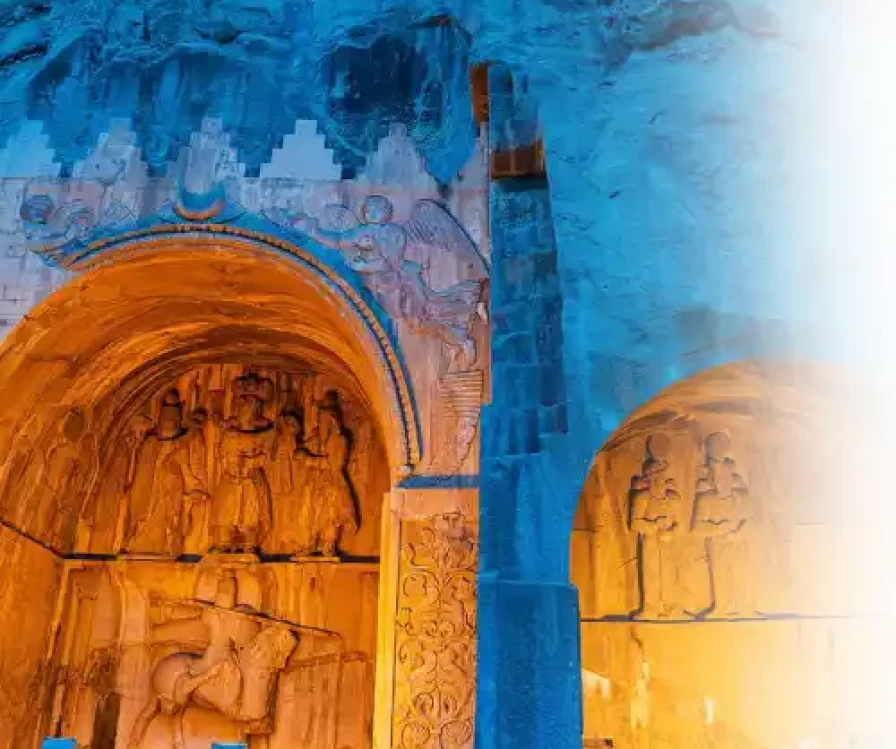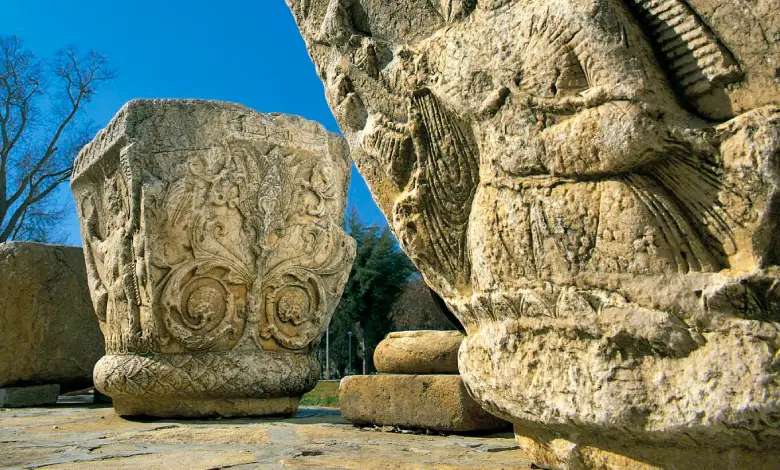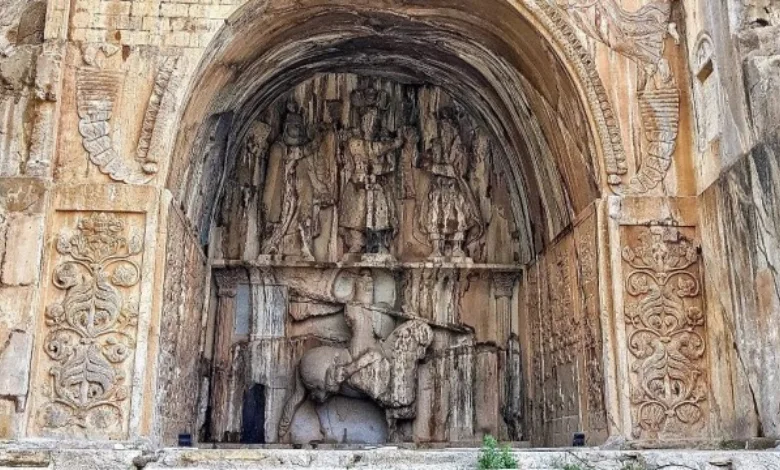
Tagh Bostan





Taq-e Bostan
Taq-e Bostan is a complex of rock carvings, inscriptions, and bas-reliefs from the Sassanid era, located in the Taq-e Bostan neighborhood, northeast of Kermanshah in western Iran. These magnificent carvings, created in the 3rd century CE, hold great artistic and historical value.
The site features several remarkable scenes from ancient times, including:
• The coronation of Khosrow II (Khosrow Parviz)
• The coronation of Ardashir II
• The joint coronation of Shapur II and Shapur III
• Inscriptions in Pahlavi script
• Scenes of royal boar
• and deer hunts, accompanied by musicians playing harps and other instruments
Thanks to its scenic spring, lake, and naturally sheltered setting, Taq-e Bostan has long served as a beautiful and tranquil resort for both local and international visitors. Each year, thousands of tourists travel to admire this unique blend of art, history, and nature.
As one of Iran’s oldest and most exquisite historical sites, Taq-e Bostan stands out as a masterpiece of ancient stone carving. Because the reliefs are carved deep into the mountain rock, they have been remarkably well preserved for nearly two millennia, capturing the attention of archaeologists and cultural heritage experts from around the world. Every year, numerous scholars and students visit the site to study its extraordinary artistry.
In Kurdish and Kermanshahi dialects, Taq-e Bostan is called Taq wa San. The word Taq means “arch,” while wa means “of,” and San means “stone.” Thus, the name literally means “stone arch.” Historical sources mention the site under other names as well. Hamdallah Mustawfi, in his 1339 CE work Nuzhat al-Qulub, referred to it as Safheh Shabdiz. Located along the ancient Silk Road, Taq-e Bostan was chosen by the Sassanid kings as a place to display their power and commemorate their victories. Earlier Sassanid monarchs had used the region around Persepolis for such purposes, following the Achaemenid tradition, but from the reign of Ardashir II onward, Taq-e Bostan became the royal setting for these symbolic carvings. In ancient times, the Kermanshah region enjoyed a wetter and more temperate climate, making it lush and verdant. Its pleasant air and strategic position on the Silk Road made Taq-e Bostan an ideal royal retreat.
The carvings at Taq-e Bostan resemble an intricate visual narrative. The depiction of Khosrow II mounted on his legendary horse Shabdiz is so vivid that it rivals the finest paintings of the world. On one side, female musicians are seen playing harps, while on the other, royal hunters pursue wild boars — scenes of action and grace that remain among the most impressive in all of ancient Iran and beyond. A close study of the carvings reveals the detailed designs of the horsemen’s garments, decorated with diamond-shaped patterns and embroidered fabrics. The king’s robe bears the image of the mythical Simurgh, while the boatmen’s and elephant riders’ outfits are richly adorned. On the side walls, one can see the king’s ceremonial attire carved as if it were made of crystal, decorated with intricate ornaments. Among the most significant reliefs is the coronation of Ardashir II — the earliest carving at Taq-e Bostan, located beside the smaller arch. In this scene, the king stands frontally at the center, with his left hand resting on his sword and his right hand receiving the royal diadem from Shapur II. Behind him stands Mithra, encircled by a halo of light, while under their feet lies the defeated Roman Emperor Julian the Apostate — a symbol of Sassanid victory over Rome. This is the only known depiction in Iran where Mithra, the god of covenant and light, appears standing on a lotus flower. Ardashir II is shown with large eyes, thick eyebrows, curly beard, and long flowing hair over his shoulders. He wears earrings with small pendants, a pearl necklace, and decorated bracelets — all rendered with astonishing precision and vitality, as though the stone had just been carved yesterday. This historic site is also immortalized in Persian literature, notably in Nizami’s Khosrow and Shirin, where it serves as a romantic and symbolic backdrop to the tale.
The most prominent monument at Taq-e Bostan is the Great Arch, featuring the coronation of Khosrow II. The vaulted chamber measures 7.85 meters wide, 11.90 meters high, and 7.65 meters deep. Around its entrance are carvings of winged angels, the Tree of Life, royal boar hunts, bird hunts, and scenes of celebration, complete with elephants, horses, and boats — all reflecting joy and royal grandeur. Beneath the coronation relief, a fully armored knight mounted on horseback is depicted. In the center stands the king; to his right is the divine figure of Ahura Mazda (or the royal Fravahar), presenting him with the ring of divine power, while to his left stands Anahita, the goddess of water, fertility, and abundance. All three figures are carved in high relief and convey a majestic sense of ceremony and spirituality.
Between the coronation of Ardashir II and the Great Arch lies the Small Arch, a rectangular niche 5.8 meters wide and 5.3 meters high, depicting the double coronation of Shapur II and Shapur III. Two inscriptions in Pahlavi script accompany the reliefs. Translation of the inscription of Shapur II (9 lines):
“This is the image of the Mazda-worshipping divine lord, Shapur, King of Kings of Iran and non-Iran, whose lineage is from the gods — son of the Mazda-worshipping divine lord Hormizd, King of Kings of Iran and non-Iran, grandson of the divine lord Narseh, King of Kings.” Translation of the inscription of Shapur III (13 lines): “This is the image of the Mazda-worshipping divine lord, Shapur, King of Kings of Iran and non-Iran, whose lineage is from the gods — son of the Mazda-worshipping divine lord Shapur, King of Kings of Iran and non-Iran, grandson of the divine lord Hormizd, King of Kings.”
In front of the arches lies a natural spring and pool that add to the site’s beauty. On the eastern side, a rock staircase of 78 carved steps leads upward into the mountain. Above the spring, a small niche carved into the rock has recently drawn scholarly interest — in November 2019, archaeologists discovered a new relief there depicting a human figure with arms raised toward the sky, holding an object resembling Latin letters, though the inscription remains undeciphered.
Another newly found carving beside the stone steps shows a similar motif. These discoveries further emphasize the long historical continuity and sacred significance of the area.
Taq-e Bostan stands today as one of Iran’s most important archaeological and artistic sites. Its intricate reliefs, natural beauty, and historical depth make it a must-see destination for scholars and travelers alike. We sincerely hope to welcome you soon to Iran and the city of Kermanshah, where the team of Sana Persian will be honored to host you.
Contact Us
+989054577261